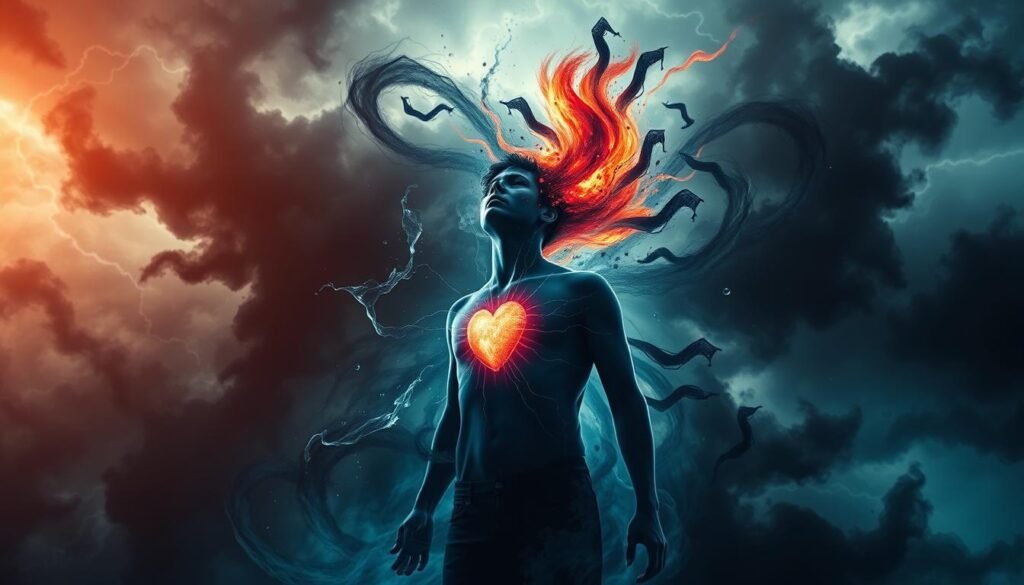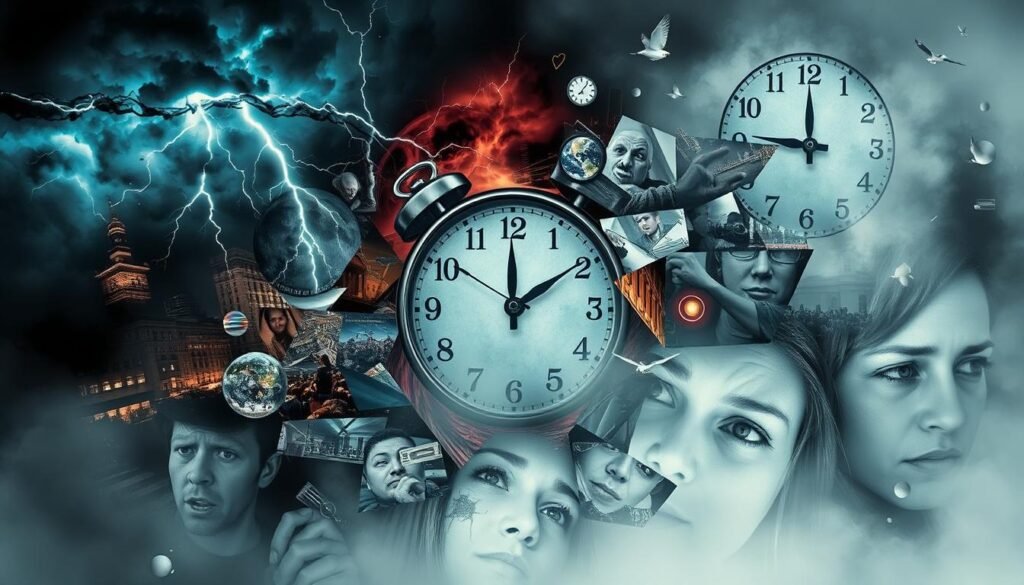About 11% of people in the U.S. have a panic attack each year. But only 2-3% get diagnosed with panic disorder. There’s a big gap that shows why we need to know the difference between panic and anxiety attacks. While panic attacks hit suddenly with intense fear and many symptoms, anxiety attacks aren’t technically a diagnosis in the DSM-5-TR.
It’s key to understand these differences. They impact how people deal with and get help for their anxiety disorders. This piece looks at the main signs and differences between panic and anxiety attacks. It aims to make things clearer for those dealing with these tough times.
Key Takeaways
- Panic attacks affect about 11% of Americans annually, but only a small fraction have a diagnosed panic disorder.
- Symptoms of panic attacks often occur suddenly and peak within minutes.
- Anxiety attacks can linger for days, weeks, or even months.
- Deep breathing techniques can help alleviate symptoms during a panic attack.
- Understanding the differences between these conditions is crucial for effective treatment.
Understanding the Definitions of Anxiety and Panic Attacks
Anxiety involves worry about future events, often due to stress. It makes people think too much about stress they feel. Many people deal with it daily. The definitions of anxiety cover many feelings like tiredness and being on edge. Studies show women are twice as likely to get anxiety disorders as men are.
Panic attacks strike suddenly and bring intense fear that reaches its worst quickly. They can happen without warning or because of certain situations. Knowing how anxiety differs from panic attacks helps us understand their impact on mental health. Symptoms of a panic attack include a racing heart, chest pain, short breathing, and feeling detached from reality.
Research shows sexual minorities are more prone to Generalized Anxiety Disorder (GAD), especially among different age groups. LGBT+ youth face anxiety or panic attacks twice as often as their peers. Panic attacks can indicate an anxiety disorder, as classified in the DSM-5 with conditions like GAD.
Panic attacks are officially recognized. Yet, anxiety attacks don’t have a clear definition in the DSM-5. Anxiety disorders are mainly what doctors see and treat in clinics. Treatments like Cognitive Behavioral Therapy (CBT) help people change their reaction to stress. CBT also helps them learn new ways to cope.
| Condition | Characteristics | Treatment Options |
|---|---|---|
| Anxiety | Chronic worry, fatigue, irritability, hypervigilance | CBT, SSRIs, SNRIs |
| Panic Attacks | Intense fear, short duration (less than 30 minutes) | CBT, understanding fight-or-flight response |
Key Differences Between Panic Attack and Anxiety Attack
Understanding the differences between a panic attack and an anxiety attack is crucial. While both share symptoms, their onset, duration, and triggers vary greatly. This knowledge helps in managing and treating them effectively.
Intensity and Severity
Sudden onset and overwhelming intensity define panic attacks. Symptoms escalate quickly, peaking within minutes. Sufferers might experience breathing difficulties, heart palpitations, and extreme fear.
These episodes typically last between 10 to 20 minutes. On the other hand, anxiety attack symptoms develop more slowly and are less severe. However, they can last much longer – hours or even weeks.
Those with anxiety face a continuous buildup of stress. This can lead to lasting feelings of nervousness and unease.
Causes and Triggers
The causes of panic and anxiety attacks are quite different. Panic attacks might strike unexpectedly, sometimes without a clear trigger. However, things like phobias or intense stress can trigger panic attacks for some people.
Anxiety attacks stem from ongoing stress related to life’s pressures, such as work or personal issues. These situations often predictably lead to anxiety, causing strong emotional responses in tough times. For more details, you can read about the differences between panic attack and anxiety attack their specific symptoms.
Panic Attack vs Anxiety Attack Symptoms: What to Look For
Knowing the symptoms of panic and anxiety attacks is crucial. They have some common symptoms but show up differently. This affects how people deal with them.
Physical Symptoms
Common symptoms of panic attacks include:
- Rapid heartbeat
- Sweating
- Trembling
- Shortness of breath
- Chest pain
- Nausea or dizziness
- Sensation of choking
- Fear of losing control or dying
Anxiety attack symptoms often include:
- Muscle tension
- Restlessness
- Fatigue
- Irritability
- Difficulties concentrating
- Sleep disturbances
Panic attacks’ symptoms usually hit suddenly and are intense. Anxiety symptoms grow slowly, causing long-lasting discomfort.
Emotional Symptoms
The emotional impacts vary too. Panic attacks bring intense fear and a feeling of doom. People may feel like they’re not in their own body during it.
Anxiety attacks lead to ongoing worry and stress over life’s challenges. Recognizing these symptoms is key.
Knowing how panic and anxiety symptoms differ helps in getting the right support fast.

Causes of Panic Attacks
Panic attacks come from different factors that affect their occurrence. Understanding the causes of panic can help people find what triggers them and get the right help. There are mainly two types: environmental triggers and health conditions. Knowing these can help greatly in dealing with panic attacks.
Environmental Triggers
Many people find certain situations can trigger their panic attacks. These are called environmental triggers. Some common ones include flying, public speaking, and being in crowded places.
These situations often lead to a fear response. Panic attacks might happen suddenly, even during everyday activities. This can be confusing and scary. Knowing what triggers an attack can help reduce how often they happen.
Underlying Health Conditions
Some health issues can make people more likely to have panic attacks. For instance, heart disease or hyperthyroidism can increase panic risk. Mental health issues, like panic disorder, can lead to ongoing panic attacks. This makes dealing with them even harder.
The main symptoms can appear suddenly and reach their peak quickly. For more details on how to deal with panic attacks and anxiety, you can check this resource.

| Triggers | Examples | Associated Risks |
|---|---|---|
| Environmental Stressors | Crowded places, flying, public speaking | Panic attacks, avoidance of situations |
| Chronic Health Conditions | Heart disease, hyperthyroidism | Increased risk of panic attacks |
| Mental Health Disorders | Panic disorder, PTSD | Repeated attacks, heightened anxiety |
Factors Contributing to Anxiety Attacks
Anxiety attacks can come from many stressors and psychological reasons. These mix with personal experiences. Knowing the core reasons helps explain how risks for anxiety disorder can increase your chance of having anxiety attacks.
Stressors and Life Events
Big life changes often trigger anxiety attacks. Stressors like losing a job, the death of someone close, or getting divorced can lead to panic. Being exposed to these stressors for a long time can make anxiety worse. It can make dealing with daily life harder. Knowing these events can help in controlling anxiety better.
Psychological Influences
Psychological factors play a significant role in the risk of anxiety attacks. Having a family with mental health issues, being naturally anxious, or past traumas can increase anxiety. Also, fearing judgment and worrying too much about social situations can make anxiety stronger. Understanding these factors gives insight into handling the causes of anxiety better.

| Type of Influence | Examples |
|---|---|
| Life Events | Job Loss, Divorce, Death of a Loved One |
| Psychological Factors | Family History, Anxious Personality, Past Trauma |
| Social Influences | Fear of Judgment, Fear of Social Interactions |
Diagnosing Panic Attacks and Anxiety Attacks
Understanding how to diagnose panic attacks and evaluate anxiety attacks is key for effective treatment. Doctors conduct thorough exams based on each person’s symptoms and history. This helps them understand and treat these attacks better.
Medical Evaluations
A full medical check-up is often required for diagnosing panic attacks. This includes:
- Physical exams to check overall health.
- Tests like an EKG to rule out other conditions that look like panic attacks.
- Mental health checks to learn about the symptoms’ severity, how often they happen, and how long they last.
Such detailed checks help figure out the exact nature and causes of panic attacks. Thus, doctors can suggest the best treatments.
Differentiating Between Conditions
It’s important to tell the difference between anxiety and panic attacks. Although doctors don’t formally diagnose ‘anxiety attacks,’ they can spot anxiety disorders by looking at symptoms. They focus on:
- The context around when symptoms appear.
- What triggers these feelings of discomfort.
- How long and how intense the symptoms are.
This careful approach creates a customized treatment plan. It aids people dealing with both panic and anxiety attacks.
| Aspect | Panic Attacks | Anxiety Attacks |
|---|---|---|
| Onset | Sudden and unexpected | Gradual, often linked to stress |
| Duration | Usually peaks within 10 minutes | Lasts longer with varying intensity |
| Symptoms | Heart racing, shortness of breath, fear of dying | Feeling nervous, tense, worried about the future |
| Frequency | Can happen many times a day or a few times a year | May last for days or weeks |
Treatment Options for Panic Attacks
Managing panic attacks usually involves both therapy and medicines, depending on what you need. The main goal is to lessen how often and how intense these attacks are. We aim to make life better overall. Below, we’ll look into cognitive behavioral therapy and different medication choices.
Cognitive Behavioral Therapy (CBT)
Cognitive behavioral therapy is now a top pick for dealing with panic attacks. This therapy helps change negative thoughts and actions that cause anxiety. Those in CBT learn ways to handle their symptoms better. This makes CBT very important for treating panic attacks. Many people start feeling better after 3 to 4 months of therapy.
Medication Approaches
Sometimes, just therapy isn’t enough. Then, doctors may add medications to the mix. Some commonly used medications are:
- Selective serotonin reuptake inhibitors (SSRIs): Options include fluoxetine (Prozac), paroxetine (Paxil), and sertraline (Zoloft).
- Serotonin and norepinephrine reuptake inhibitors (SNRIs): Venlafaxine (Effexor XR) is approved for treating panic disorder.
- Benzodiazepines: For quick relief, alprazolam (Xanax) and clonazepam (Klonopin) may be used.
It can take a few weeks for the medication to start working well. Making lifestyle changes is also crucial. Things like exercising, dealing with stress, and not having too much coffee or alcohol help a lot. Joining a support group can give you extra help and encouragement.
Conclusion
Understanding the key differences between panic and anxiety attacks is crucial. It helps in identifying and dealing with each condition. Panic and anxiety attacks may seem similar but have distinct features, causes, and ways to manage them. Recognizing these can lead to better mental health.
Panic attacks often peak in intensity in just 10 minutes. They last from 20 to 30 minutes, while nighttime episodes are shorter, lasting two to eight minutes. Knowing the duration, triggers, and symptoms is essential. This knowledge is a big step in managing anxiety disorders.
Getting help from professionals and using self-help methods like relaxation techniques are vital for recovery. These approaches can improve how individuals handle anxiety disorders. They help build emotional strength and lower the chances of experiencing episodes. This way, life’s quality gets better.